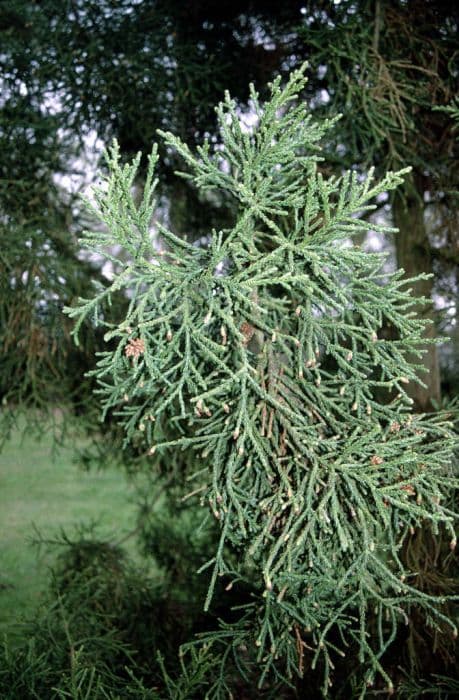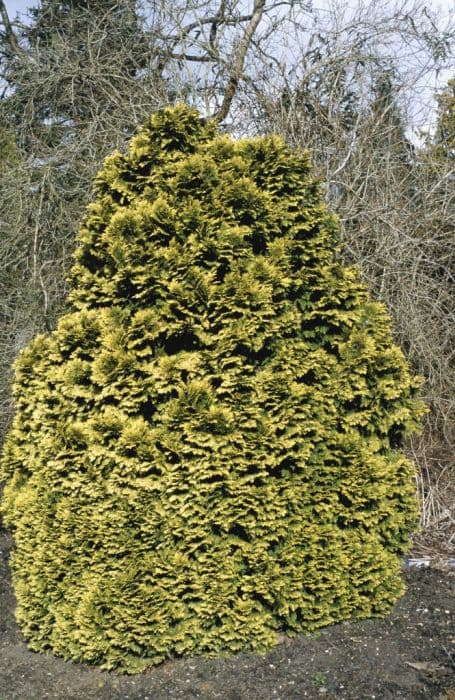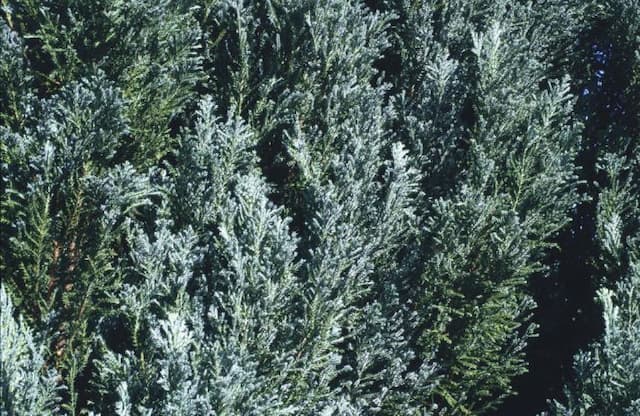Lawson's Cypress Chamaecyparis lawsoniana 'Green Hedger'











ABOUT
The Green Hedge is a cultivar noted for its lush evergreen foliage, with a dense, conical shape that resembles a classic hedge structure. Its leaves are fine-textured sprays that retain a deep green hue throughout the year, giving it a vibrant, healthy look even in the coldest months. The foliage is soft to the touch and has a feathery appearance, with the leaves arranged in flattened sprays that give it a full-bodied look. The plant exudes a fresh, woodsy fragrance that is characteristic of many evergreen conifers. This cultivar is often used in landscaping for its attractive appearance and its utility as a natural privacy screen due to its dense growth habit.
About this plant
 Names
NamesFamily
Cupressaceae
Synonyms
Lawson's Cypress, Oregon Cedar, Port Orford Cedar
Common names
Cupressus lawsoniana, Chamaecyparis lawsoniana var. lawsoniana.
 Toxicity
ToxicityTo humans
The plant known as Lawson's cypress is generally considered to have low toxicity to humans. However, like many plants, it could potentially cause irritation or allergic reactions if ingested or if sensitive individuals come into contact with its sap. Ingesting parts of this plant might lead to gastrointestinal discomfort such as nausea, vomiting, or diarrhea. Though not commonly associated with severe poisoning, care should be taken to avoid ingestion, particularly by children or pets, and to avoid contact with the sap if you have sensitive skin.
To pets
Lawson's cypress can also be considered to have low toxicity to pets, but it can still cause gastrointestinal upset if ingested. Symptoms of poisoning in pets might include vomiting, diarrhea, and possibly drooling if the sap comes into contact with their mouth or skin. While serious complications are unlikely, it's important to prevent pets from chewing on or ingesting this plant to avoid any potential discomfort or allergic reactions. If a pet does ingest Lawson's cypress and shows symptoms of distress, it is advisable to consult with a veterinarian.
 Characteristics
CharacteristicsLife cycle
Perennials
Foliage type
Evergreen
Color of leaves
Green
Height
10-15 feet (3-4.5 meters)
Spread
4-6 feet (1.2-1.8 meters)
Plant type
Tree
Hardiness zones
5-8
Native area
North America
Benefits
 General Benefits
General Benefits- Ornamental Value: The Lawson Cypress 'Green Hedger' provides year-round ornamental interest with its rich green foliage and conical shape.
- Privacy Screening: It grows dense and tall, making it ideal for creating private spaces in gardens and landscapes.
- Noise Reduction: The thick foliage can help dampen noise from roads and neighbors when planted in a hedge or barrier form.
- Windbreak: When planted in rows, it can act as a windbreak, protecting gardens and homes from strong winds.
- Habitat Support: It offers shelter and nesting sites for birds and other wildlife.
- Low Maintenance: Requires minimal care once established, aside from occasional pruning to maintain shape.
- Soil Erosion Control: Its root system helps stabilize the soil, preventing erosion, particularly on slopes.
- Durable in Various Climates: Tolerates a range of temperatures and climates, making it a versatile choice for many regions.
- Adaptability: Lawson Cypress 'Green Hedger' can adapt to a variety of soil types, though it prefers well-drained soils.
- Resistant to Deer: The plant is generally resistant to browsing by deer, making it suitable for rural and suburban areas where deer are a concern.
 Medical Properties
Medical PropertiesThis plant is not used for medical purposes.
 Air-purifying Qualities
Air-purifying QualitiesThis plant is not specifically known for air purifying qualities.
 Other Uses
Other Uses- Woodworking – The wood of Lawson's Cypress is valued for its fine texture and is often used to make furniture, musical instruments, and decorative items.
- Model Building – Due to its fine grain, the wood is also highly regarded in model making, including model trains and architectural models.
- Fence Posts – The natural rot resistance of Lawson's Cypress makes it suitable for outdoor uses, such as fence posts and garden structures.
- Scented Items – The aromatic qualities of the wood can be used in the production of scented items like sachets and potpourris.
- Shipbuilding – Historically, the rot-resistant nature of the wood has been employed in shipbuilding for specific parts that needed to last in wet environments.
- Crafting – The wood can be used for various craft projects, where the quality of the wood adds aesthetic value to the finished product.
- Aquariums – When properly treated, branches can be used in aquariums as a natural decoration that offers hiding places for fish.
- Garden Path Borders – The plant can be pruned into shapes to create visually pleasing borders along garden paths.
- Christmas Decorations – The foliage is sometimes used in wreaths and other holiday greenery for its pleasant smell and lush look.
- Bonsai – Although not common, some enthusiasts may utilize Lawson's Cypress for creating bonsai trees due to its evergreen nature and scale-like leaves.
Interesting Facts
 Feng Shui
Feng ShuiThe Lawson cypress is not used in Feng Shui practice.
 Zodiac Sign Compitability
Zodiac Sign CompitabilityThe Lawson cypress is not used in astrology practice.
 Plant Symbolism
Plant Symbolism- Longevity: Lawson's cypress, also known as Port Orford cedar, is known for its longevity. This tree species can live for many years, symbolizing endurance and the continuity of life.
- Sanctuary: With its thick foliage and evergreen nature, this plant is often associated with providing a protective sanctuary, symbolizing safety and shelter.
- Purity: The Lawson's cypress has been associated with purity due to its clean, fresh scent and its role in purifying the air, representing cleanliness and freshness in one's life.
- Serenity: The tranquil and calm presence of Lawson's cypress can symbolize peace and serenity, suggesting a sense of calmness and quiet strength.
- Healing: Traditionally, many parts of the Lawson's cypress have been used for their healing properties. Thus, the plant can symbolize health and restoration.
 Water
WaterThe Lawson Cypress 'Green Hedger' should be watered thoroughly, but the frequency depends on the climate and soil conditions. In general, it's essential to keep the soil consistently moist but not waterlogged. During the dry season or in arid climates, watering may be necessary once or twice a week, supplying about 1-2 gallons per plant each time, depending on the size and maturity of the tree. Ensure water penetrates the soil deeply to encourage strong root growth. Reduce watering during the cooler months to prevent root rot, and adjust the schedule based on rainfall to avoid overwatering.
 Light
LightThe Lawson Cypress 'Green Hedger' prefers full sun to partial shade. For optimal growth, it should be planted in an area where it can receive at least four to six hours of direct sunlight each day. However, in particularly hot climates, some afternoon shade can be beneficial to prevent scorching. Avoid deep shade locations as this can lead to sparse growth and a less dense foliage form.
 Temperature
TemperatureThe Lawson Cypress 'Green Hedger' thrives in a temperature range of 20°F to 80°F, which is typical for its hardiness zone. It can survive extremes from -10°F to 90°F for short periods. The ideal growing conditions for the 'Green Hedger' involve temperatures that are cool to moderate, as it is adapted to cooler climates and may struggle with heat stress if temperatures consistently exceed the upper limit.
 Pruning
PruningPruning the Lawson Cypress 'Green Hedger' is necessary to maintain its desired shape and to remove any dead or diseased branches. Light pruning should be done in late winter or early spring before new growth starts. It's best to prune sparingly, only cutting back to a green shoot, as the plant may not regrow from old wood. Periodic thinning can help maintain the health of the plant by increasing air circulation.
 Cleaning
CleaningAs needed
 Soil
SoilLawson's Cypress 'Green Hedger' thrives best in moist, well-drained soil with a slight acidic pH, ideally between 5.5 and 6.5. A mix with loamy soil, peat moss, and a good portion of perlite or sand for aeration would create an optimal environment for root health and growth.
 Repotting
RepottingLawson's Cypress 'Green Hedger' should be repotted every three to five years. It's best to repot in the spring just before new growth starts, ensuring the plant settles well in its new container.
 Humidity & Misting
Humidity & MistingLawson's Cypress 'Green Hedger' prefers outdoor conditions where it can receive average to high humidity typical of its natural environment. Indoor humidity levels should ideally mimic this, but it is less of a concern when grown outdoors.
 Suitable locations
Suitable locationsIndoor
Provide bright light, cool temps, and moist air for Lawson's Cypress.
Outdoor
Plant in sun to part-shade, protect from harsh winds, ensure moist soil.
Hardiness zone
5-8 USDA
 Life cycle
Life cycleLawson's Cypress 'Green Hedger' begins its life as a seed, typically requiring a period of cold stratification to break dormancy. Once germinated, the seedling phase sees rapid root and shoot growth given appropriate conditions of moisture and light. As it transitions into the juvenile phase, the plant's characteristic conical shape starts to form with dense, scale-like foliage. During the mature phase, which can last many decades, the tree continues to grow in height and girth, capable of reaching up to 200 feet in optimal conditions, although the 'Green Hedger' cultivar generally remains much smaller. It develops cones that contain seeds, allowing it to reproduce and ensuring the next generation. Throughout its life, the evergreen nature maintains a year-round display of greenery, with minimal seasonal foliage change.
 Propogation
PropogationPropogation time
Early Spring
The most popular method of propagation for the Lawson's Cypress 'Green Hedger' is through semi-hardwood cuttings. This process generally takes place in late summer to early fall, when the growth has begun to harden but is not yet fully mature. Cuttings of about 4 to 6 inches (approximately 10 to 15 centimeters) are taken from the current year’s growth. The cut end of the cutting is usually treated with a rooting hormone to encourage root development and then is inserted into a well-draining soil mix. The cuttings require consistent moisture and a humid environment, which can be maintained by covering the cuttings with a plastic dome or using a misting system. After a few weeks to months, the cuttings will develop roots and can be transplanted to individual pots to grow on before being planted out.









